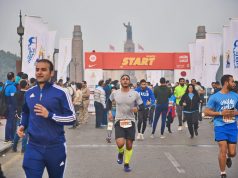
As we escape from our desks and daily routine to head to the holiday hotspots, we look forward to getting lots of healthy exercise in the fresh air. Sounds good? So what’s the catch? We catch up with Assistant Professor of Physical Medicine and Rheumatology Dr. Rana El-Hilaly to find ways to avoid any stress and strain that could spoil our holiday fun.
CWM: Dr. Rana, what type of injuries and complaints do you see more of as the summer holiday season begins?
RH: Musculoskeletal injuries surge in the summer. Fractures, sprains, strains, lacerations are by far the most common. The most frequently torn muscles include the hamstrings (back of leg), quadriceps (front of leg) and calf muscles. The most common injured ligaments we see are sprained ankles and torn or strained knee ligaments (including the famous ACL). Common foot injuries can include plantar fasciitis and Achilles tendinitis. Shoulder pain, especially subacromial bursitis with symptoms that can include loss of strength and pain when lifting the arm can take a few weeks to resolve.
Why is this?
Summer holidays are traditionally a season of fun, sports and outdoor activities, so injuries are common as we tend to become more active than usual with cycling, swimming, surfing, tennis, beach volleyball, water and racquet-based sports. These sports rely on muscular strength and need highly repetitive movements. Unfortunately, even mild weaknesses can be exposed in these cases and cause an injury.
How can they be treated?
Simple sprains and strains can be managed conservatively and most often do not require an ER visit. First aid comes in the form of RICE (Rest, Ice, Compression and Elevation) initially, and then we commence rehabilitation to improve movement of the joint, restoring strength of the muscles affected and proprioception (balance) around the joint.
Over-the-counter anti-inflammatory drugs and topical treatments available by prescription are used for musculoskeletal injuries with supports, slings and bandages according to the case.
What can people do to avoid these problems?
Wear proper footwear. Your shoe soles should have adequate grip, a secure fit, and if applicable, shoelaces should be securely tied. Get some sandals with a bit of support around arches and ankle if you’re looking for the minimum shoe option this summer. If you’re going for a barefoot beach run, try to make it short and sharp – don’t try to run your usual distance. Beach sprints or intervals may work well to keep the distance down and still give you a good workout
Try to avoid long sessions in the surf or the pool, especially if you’re not a regular swimmer or surfer. If your shoulder starts to hurt playing tennis, try to stop overhead serving and keep your shots to forehand or backhand or take a good rest and try again if the pain settles
Accidents due to skateboards, scooters, rollerblades and push-bikes are common, buying a helmet and knee pads is a must
What issues arise in the various age groups?
Children and adolescents (aged 5 to 17 years) have similar distribution of injuries in both sexes, with sprains and strains occurring most commonly, followed by fractures and/or dislocations. The most common causes of injury were found to be overexertion and strenuous movements, generally caused by overuse related to bicycle riding, skating, and swimming.
Adults (aged 18 to 39 years) usually tear back muscles by lifting incorrectly, or turning suddenly in sporting activities especially in the gym, which may also cause ligament and tendon injuries and can affect other joints such as shoulders, knees and hips.
Neck pain, low back pain and Sciatica are the complaints of the middle age group (aged 40 to 64 years) trying to become highly active in a short time after being sedentary for too long.
Two of the most common reasons of injuries in elders (aged over 64 years) are falls and lacerations. Complications, such as ankle sprain, will affect recovery time and slow re-conditioning.
Which are the top 3 things to remember when we demand more of our bodies than usual?
1- Prepare your body for the hard work. Stretching before exercising can help loosen your muscles and improve your range of motion before you begin a strenuous physical activity. This ensures your body can handle intense physical activity, cool down gradually towards the end of your exercise rather than abrupt cessation and remember to breathe in and out all through the activity.
2- Know your limits. Start off slow when beginning a new physical activity. Build up your tolerance for each new physical task. Avoid taking on too much at once, as this can lead to muscle strain and other musculoskeletal injuries
3- Keep your body hydrated (drink plenty of water) to avoid muscle cramps and follow a healthy diet plan with good sleep.
Are there any basic strengthening and toning exercises you can recommend?
Aim for 20 to 30 minutes of strength training exercises two to three times a week―with at least one day off in between workouts so your muscles have time to rest, recover, and grow.
Squat: Works Buttocks and thighs
One-Arm Row: Works Upper and middle back and shoulders
Modified Push-Up: Works Chest, abdominals, shoulders, and arms
Shoulder Press: Works Shoulders, arms
Biceps Curls: Works Biceps

Kick-Backs: Works Triceps
Plank: Works Abdominals, shoulders, chest, lower back, buttocks, thighs. You can do two sets each of 10-30 repetitions
Bio:
Dr. Rana El- Hilaly
Assistant Professor of Physical Medicine and Rheumatology, Ain Shams University.
Al Mashfa Psychiatric and Physical Rehabilitation Hospital





